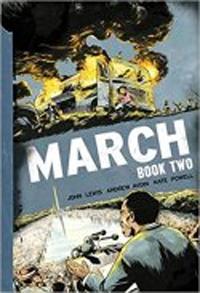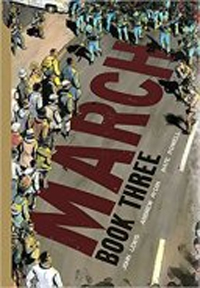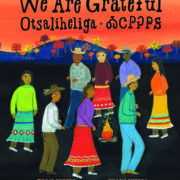March: Books 1-3 by John Lewis with Andrew Aydin, art by Nate Powell



Of all the treasures in the Smithsonian, the exhibit that sticks with me the most is a pair of petite, scuffed, rundown, women’s loafers worn during the 1965 civil rights march from Selma to Montgomery, Alabama. I found the shoes in a distant corner on the upper floor of the National Museum of American History, tucked safely in a display case with photographs and posters from the trek. The case had been relocated due to renovations elsewhere in the museum, and I was lucky to run across it. Those shoes mesmerized me. They had been worn for all 54 miles of the march and showed it. I can only imagine what it had been like to wear them.
I am equally mesmerized by March: Books 1-3, the graphic novel trio by John Lewis with Andrew Aydin and art by Nate Powell.  John Lewis, currently a U.S. Representative from Georgia, has spent his life in the civil rights movement. As a young man, he chaired the Student Nonviolent Coordinating Committee (SNCC), a key group in the movement. He organized sit-ins to desegregate lunch counters, participated in the Freedom Rides, helped organize the 1963 March on Washington, and helped lead the 1965 march from Selma to Montgomery.
March is Lewis’ memoir of his civil rights work in the 1950s-60s.  It’s an insider’s look at the movement from a less well-known perspective. Lewis lays out the motivation for his actions and decisions as well as those of the movement’s student wing. He provides insight into the internal politics of the various organizations behind the movement. His descriptions and Nate Powell’s drawings reflect the brutality of the struggle for equality–humiliation, beatings, incarceration, bombings, torture, death.  March accurately reflects the times it depicts; as a result, it’s not always easy to look at or to read.
Lewis bookends the movement’s history with scenes from the first presidential inauguration of Barack Obama.  Book One opens with Lewis preparing for the event; as he stops by his Capitol Hill office, he meets a woman wanting her young sons to understand the significance of the day.  Lewis pauses to relate the history of the civil rights movement to her sons, and the story begins. Although somewhat awkward as a narrative device–additional scenes with Lewis speaking to the woman appear to serve as transitions at different points in the books–the intensity and immediacy of the art and text make up for it. Lewis anchors his experiences around the 1965 march from Selma to Montgomery, hence the title.  All 3 volumes echo the call of “We’ll march!â€, building up to the Alabama trek’s successful conclusion at the end of Book Three.
Nate Powell’s drawings may only be in grayscale, but they make as much impact as full color. He uses a mix of bold strokes and detailed shadings to convey a wide range of emotions. He incorporates large swaths of black background (sometimes a majority of a two-page spread) to highlight text or fine drawings or grave subject matter. Powell cleverly incorporates the sizable amount of text in his drawings without sacrificing space or emotional power. He has a tremendous capacity to capture facial expression and body language, portraying with equal skill reflective thoughtfulness and intense hate demonstrated by both black and white figures. The books have won multiple Eisner Awards (the graphic novel world’s equivalent of the Oscars) for a reason.
March: Books 1-3 is an intense, fascinating exploration of our nation’s recent history. It’s a natural choice for graphic novel or memoir fans and history buffs. It has plenty to offer a wider audience, however. Give the first volume or all 3 to high school students and adults; the books are equally interesting as part of a broader discussion or enjoyed alone. Be prepared to provide context for or an introduction to the civil rights movement for middle students who read March as it accurately portrays the events and language of the time.  Like that unassuming pair of shoes in the Smithsonian, Lewis’ memoir holds a powerful message.











